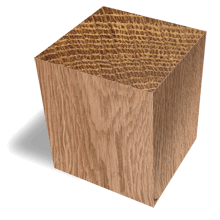
Brown Oak
Brown Oak typically refers to English Oak (Quercus robur), a native deciduous tree widely found across the UK and Europe, which has undergone a natural colour transformation due to the “beefsteak” fungus (Fistulina hepatica). This fungus grows on living oak trees, secreting acids that react with the wood’s tannins, staining it while the tree is still standing. English Oak trees grow to 50–100 feet tall with trunk diameters of 3–5 feet, thriving in a variety of soils, often in mixed woodlands.
The heartwood of Brown Oak is a rich, warm brown, often with reddish or purplish undertones, darker and more vibrant than the natural pale golden-brown of untreated oak. The sapwood remains a pale cream or light yellowish-brown, clearly distinct. The grain is straight to slightly wavy, with a medium to coarse texture typical of oak, and a moderate natural lustre. The fungal staining can create subtle figuring or colour variations, adding depth and character to the wood.
Brown Oak has a density of around 650–750 kg/m³, similar to regular English Oak, making it moderately hard and strong with good stability once seasoned. It’s reasonably durable, offering some natural resistance to decay, though it’s susceptible to insect attack if untreated, particularly by wood-boring beetles. The wood works well with both hand and machine tools, though its coarse grain can lead to tearout if tools aren’t sharp. It glues, stains, and finishes effectively, with the brown hue often enhanced by oil-based finishes that bring out its warmth and depth.
When worked, Brown Oak has a faint, oaky aroma, sometimes with a slightly earthy note from the fungal influence. It’s prized for its unique colour and is often used in high-end furniture, panelling, flooring, and cabinetry, particularly for bespoke or historical reproductions in the UK, where its rich tone adds a sense of age and character. It’s also suitable for structural uses like beams, though its primary appeal is decorative.
Brown Oak is less common than standard oak, as the fungal staining occurs naturally in only a small percentage of trees, making it a premium choice. It’s moderately expensive, valued for its aesthetic over regular oak, and its availability depends on the occurrence of the beefsteak fungus in oak populations.
